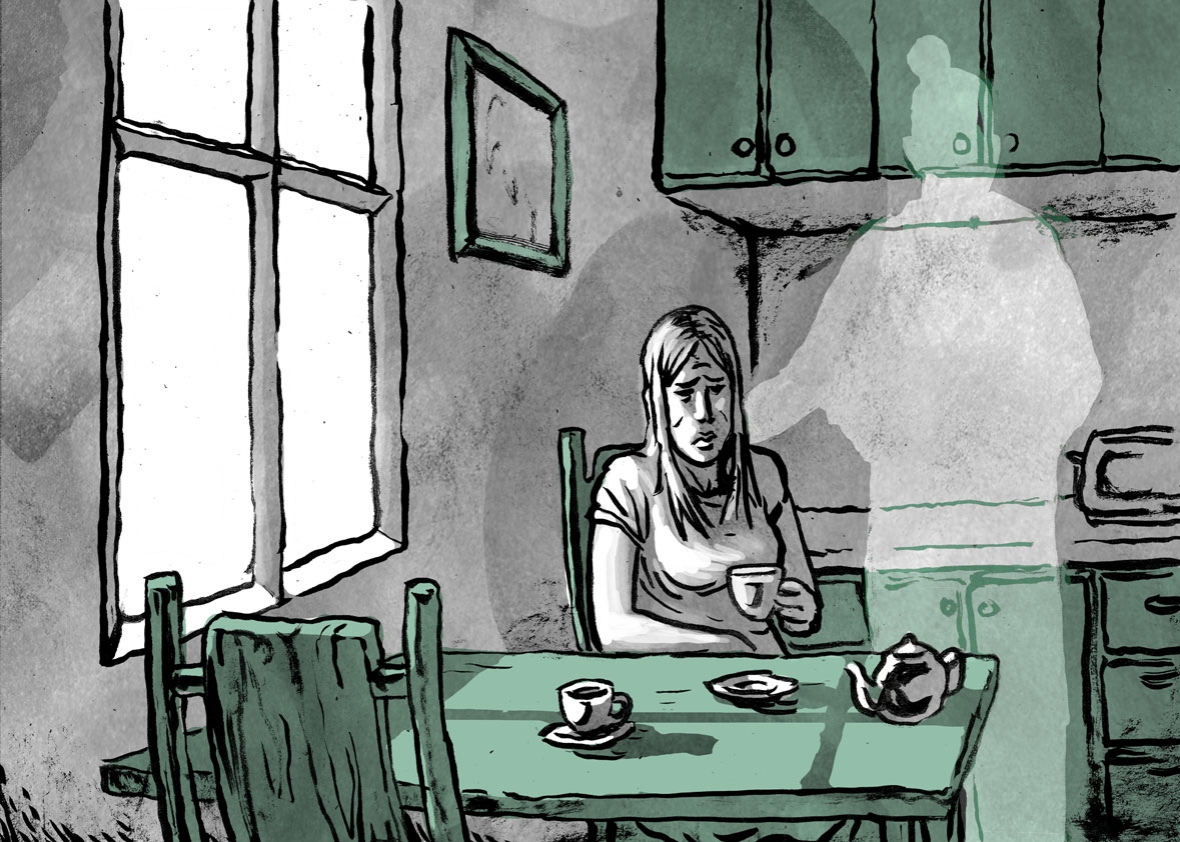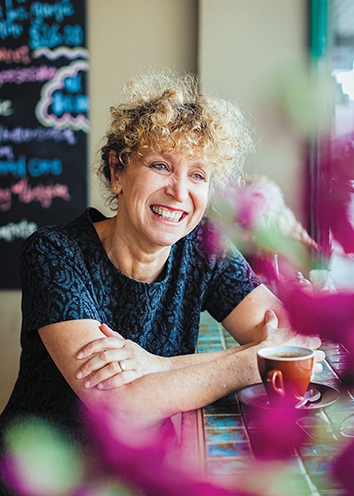
Slate is an Amazon affiliate and may receive a commission from purchases you make through our links.
The Next Generation
A sharp novel about the daughter of Holocaust survivors living in Israel.

imon Roy
Holocaust literature emerged out of a need to tell the stories of trauma in all its complexity. Books about the generation that was birthed by Holocaust survivors are not as common. There’s Maus, by Art Spiegelman, and another comic, the recent Flying Couch by Amy Kurzweil. Sonia Pilcer’s The Holocaust Kid explores the terrain with short stories of a ’60s New York girl trying to keep her parents’ past in her present, while Second Hand Smoke by Thane Rosenbaum is a mystery with postmodern sensibilities and a card-shark heroine. Leah Kaminsky’s The Waiting Room, released in Australia in 2015 and now published in the U.S., adds to this small list; set in Israel, a country where survivors have been both looked down upon and revered, Kaminsky’s novel explores intergenerational trauma with approachable simplicity.
Dina, the protagonist of The Waiting Room, is a second-generation survivor from Australia living in Haifa, Israel’s most diverse city, during one of its most polarizing times, the Second Intifada in the early 2000s. But her heart isn’t in the conflict-ridden state; it is in Australia, where her parents’ bones are buried. Throughout the novel, Dina is beset with memories of her childhood in a Melbourne suburb where she grew up with “aunts” and “uncles” who were not related to her by blood but rather by history. Survivors of the Holocaust who emigrated to Australia from Europe, they were the backdrop of Dina’s early years and the only kind of extended family she had.
Some of those survivors, like Dina’s father, never spoke about their experiences in the camps. But for others, like Dina’s mother, the silence broke and became an obsessive rehashing of the terrors—much like the authors of Holocaust literature, the storytellers were trying to understand what they’d been through. Indeed, Dina’s mother, though dead, still tells the stories; her ghost emerges from the ether whenever her daughter least wants her around. The epitome of the Jewish mother, she kibitzes about old grievances and tells Dina off for being displeased with her lot, but most of all, she continues to tell stories from her time in Bergen-Belsen, endlessly repeating her own traumatic tales for the benefit of her very pregnant daughter.
The trauma of the past is very different from the trauma of the present in which The Waiting Room takes place. Dina is living in Israel of the early 2000s, when bomb scares and bombs feel like daily occurrences. Her husband Eitan is a strapping Israeli tsabar, a resident born and bred in Israel, and Dina owns her own medical practice in Haifa.
Most of the novel takes place during the morning and early afternoon of a single day when Haifa is put on bomb alert, the morning news warning residents to be especially vigilant—there is no explanation for how or why, but residents understand that the source of the information is Israeli intelligence. Dina spends the hours dreading the possible bomb—the location of which is unknown—despite knowing that alerts are common and often don’t lead to anything. She falls into reveries spurred on by her mother’s presence and loses sense of where she is. Her disappearance into memories is helpful for the reader, as it fills in useful backstory, but it’s also an apparent symptom of her second-generation trauma. (Dissociation, which seems to be what Dina experiences during these trips down memory lane, is a symptom of post-traumatic stress disorder.)
Eitan dismisses Dina’s concerns, and their son is comfortable with the situation. As Eitan says, “There are hundreds of warnings every day in this country. The kids get used to it; life goes on.” Israeli children grow up being conditioned to think that they are in danger, surrounded by enemies (a common refrain referring to the countries bordering Israel on three sides).

Nicola Bernardi
Though the reality of second- (and third-) generation syndrome used to be oft-disputed, recent studies have found that trauma can be passed through generations and leave genetic evidence in offspring’s cells. Symptoms vary but can include anxiety, eating disorders, intense fear over the death of loved ones, and a need to overly care for them. It is primarily the last two of these that affect Dina—her fear for her son intertwines with her memories of taking care of her mother when she was a teenager. Dina’s haunting mother—as well as a couple of fantasies where she slips into her mother’s shoes at Bergen-Belsen—convey the most literal symptoms of PTSD.
Dina’s childhood was safe, unlike her son’s, and so even though the images of her mother’s depression are etched into her mind, the physical danger of living in a country where suicide bombers are commonplace is foreign to her. But she is far more Israeli than she thinks, even if she’s still considered an outsider by her husband. In one memorable scene, she rushes to her son’s school with the premonition that he is in danger; she becomes convinced that one Arab worker at the school, wearing a bulky jacket, is hiding a suicide bomb. Anyone who’s lived in Israel has seen a moment of casual xenophobia that turns quickly into panic and rage, or undergone one herself.
At the same time, Israelis are often quite aware of the realities of other foreigners who come into their country. When Dina is at the supermarket, she encounters a patient of hers, escorted by Jane, a Filipina who’s come to Israel to work as a caretaker for the elderly. “She has probably left her family behind in some poor village,” Dina thinks, “and come miles away from home to look after a garrulous old lady … on a salary of $500 a month.” Though Dina too served as a caretaker for her mother, she doesn’t see the similarities between her and Jane: both self-exiled from their homes, both working too hard, both putting on masks of patience so no one will see their real frustrations. The difference being, of course, that no matter how much Dina feels like an outsider, she is still in a much better condition that Jane and has the privilege to think of her as a poor soul worthy of pity.
Kaminsky uses plain language for these moments. Though the novel is primarily a portrayal of a woman still mourning her mother, it’s possible to read through the lines of The Waiting Room to analyze Israeliness, xenophobia, Holocaust trauma, and more. Dina’s clinic is a convenient place for Kaminsky to explore the diversity of Haifa: Over the course of her morning appointments, Dina encounters the same garrulous old lady mentioned above, a Christian Palestinian woman hoping to have a son, and a hypochondriac Russian immigrant. Though these could read as stereotypes of the Israeli population, Kaminsky handles them with grace, though occasionally she, like Dina, seems to suffer from “compassion fatigue,” as these characters’ stories aren’t explored as deeply as they could have been.
In the end, The Waiting Room is not only Dina’s story but that of a second-generation diaspora who chose to move to Israel despite their parents eschewing that option after World War II. But Kaminsky is at her strongest when handling the relationship between Dina and her mother, who, while annoying, is also a font of Zen-like wisdom. “You kid yourself you have some sort of control over life,” Dina’s mother says, adding, “There’s freedom in futility.” The novel is an example of an uncontrollable day in Dina’s life, and her mother’s ghost is, in more ways than one, the reason Dina stays alive to see its end.
---
The Waiting Room by Leah Kaminsky. Harper Perennial.
Read the rest of the pieces in the Slate Book Review.
The Waiting Room
Check out this great listen on Audible.com. The waiting room stands on a crumbling railway platform at the edge of a retired rock star's vast estate. Abandoned to dereliction and isolated by a moat of thorny wilderness, it used to be a playground for his children. Until strange music and the terr...